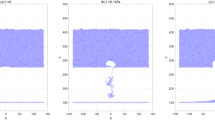Abstract
With the advance of the finite element method, general fluid dynamic and traffic flow problems with arbitrary boundary definition over an unbounded domain are tackled. This paper describes an algorithm for the generation of anisotropic mesh of variable element size over an unbounded 2D domain by using the advancing front ellipse packing technique. Unlike the conventional frontal method, the procedure does not start from the object boundary but starts from a convenient point within an open domain. The sequence of construction of the packing ellipses is determined by the shortest distance from the fictitious centre in such a way that the generation front is more or less a circular loop with occasional minor concave parts due to element size variation. As soon as an ellipse is added to the generation front, finite elements are directly generated by properly connecting frontal segments with the centre of the new ellipse. Ellipses are packed closely and in contact with the existing ellipses by an iterative procedure according to the specified anisotropic metric tensor. The anisotropic meshes generated by ellipse packing can also be used through a mapping process to produce parametric surface meshes of various characteristics. The size and the orientation of the ellipses in the pack are controlled by the metric tensor as derived from the principal surface curvatures. In contrast to other mesh generation schemes, the domain boundary is not considered in the process of ellipse packing, this reduces a lot of geometrical checks for intersection between frontal segments. Five examples are given to show the effectiveness and robustness of anisotropic mesh generation and the application of ellipse packing to mesh generation over various curved surfaces.













Similar content being viewed by others
References
Watson DF (1981) Computing the n-dimensional delaunay tessellation with application to voronoi polytopes. Comput J 24 (2):167–172
Yerry MA, Shephard MS (1983) A modified quadtree approach to finite element mesh generation. IEEE Comput Graph Appl 3(1):39–46
Lo SH (1985) A new mesh generation scheme for arbitrary planar domains. Int J Numer Meth Eng 21(8):1403–1426
Lo SH (1989) Delaunay triangulation of non-convex planar domains. Int J Numer Meth Eng 28 (11):2695–2707
Weatherill NP (1990) The integrity of geometrical boundaries in the 2-dimensional Delaunay triangulation. Commun Appl Numer Meth 6(2):101–109
Borouchaki H, Lo SH (1995) Fast Delaunay triangulation in three dimensions. Comput Meth Appl Mech Eng 128(1–2):153–167
Lau TS, Lo SH (1996) Finite element mesh generation over analytical curved surfaces. Comput Struct 59(2):301–309
Lohner R (1996) Extensions and improvements of the advancing front grid generation technique. Commun Numer Meth Eng 12(10):683–702
Owen SJ, Saigal S (2000) H-Morph: an indirect approach to advancing front hex meshing. Int J Numer Meth Eng 49(1–2):289–312
Bossen FJ, Heckbert PS (1996) A pliant method for anisotropic mesh generation. In: 5th International Meshing Roundtable, Sandia National Laboratories, pp 63–76, October 1996
Yamada A, Shimada K, Itoh T (1999) Meshing curved wire-frame models through energy minimization and packing of ellipses. Int J Numer Meth Eng 46(8):1221–1236
Shimada K, Yamada A, Itoh T (2000) Anisotropic triangulation of parametric surfaces via close packing of ellipsoids. Int J Comput Geom Appl 10(4):417–440
Lo SH (2001) 3D anisotropic mesh refinement in compliance with a general metric specification. Finite Elem Anal Des 38(1):3–19
Borouchaki H, Frey PJ (1998) Adaptive triangular-quadrilateral mesh generation. Int J Numer Meth Eng 41(5):915–934
Lee YK, Lee CK (2002) Automatic generation of anisotropic quadrilateral meshes on three-dimensional surfaces using metric specifications. Int J Numer Meth Eng 53(12):2673–2700
Borouchaki H, George PL, Hecht F, Laug P, Saltel E (1997) Delaunay mesh generation governed by metric specifications. 1. Algorithms. Finite Elem Anal Des 25(1–2):61–83
Borouchaki H, George PL, Mohammadi B (1997) Delaunay mesh generation governed by metric specifications. 2. Applications. Finite Elem Anal Des 25(1–2):85–109
Lee CK (2001) On curvature element-size control in metric surface mesh generation. Int J Numer Meth Eng 50(4):787–807
Lee CK (2003) Automatic metric 3D surface mesh generation using subdivision surface geometrical model. Part 1: Construction of underlying geometrical model. Int J Numer Meth Eng 56(11):1593–1614
Borouchaki H, Laug P, George PL (2000) Parametric surface meshing using a combined advancing-front generalized Delaunay approach. Int J Numer Meth Eng 49(1–2):233–259
Borouchaki H, Laug P, George PL About parametric surface meshing. In: 2nd Symposium on Trends in Unstructured Mesh Generation, USNCCM’99, University of Colorado, Boulder, CO, USA
Lo SH, Wang WX (2004) A fast robust algorithm for the intersection of triangulated surfaces. Eng Comput 20(1):11–21
Sharov D, Luo H, Baum JD, Lohner R (2004) Unstructured Navier-Stokes grid generation at corners and ridges. Int J Numer Meth Fluid 43:717–728
Wong SC, Lee CK, Tong CO (1998) Finite element solution for the continuum traffic equilibrium problems. Int J Num Meth Eng 48:1253–1273
Lo SH, Wang WX (2003) An algorithm for the intersection of quadrilateral surfaces by tracing of neighbours. Comput Meth Appl Mech Eng 192(20–21):2319–2338
Acknowledgements
The work described in this paper was supported by a grant from the Research Grants Council of the Hong Kong SAR Government on the project HKU7117/04E “Analysis of transfer plate structures using high-performance solid 3D hybrid stress hexahedral elements”.
Author information
Authors and Affiliations
Corresponding author
Rights and permissions
About this article
Cite this article
Lo, S.H., Wang, W.X. Generation of anisotropic mesh by ellipse packing over an unbounded domain. Engineering with Computers 20, 372–383 (2005). https://doi.org/10.1007/s00366-005-0317-7
Received:
Accepted:
Published:
Issue Date:
DOI: https://doi.org/10.1007/s00366-005-0317-7




